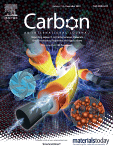Sejeong Won, Hyun-June Jung, Dasom Kim, Sang-Hun Lee, DoVan Lam, Hyeon-Don Kim, Kwang-Seop Kim, Seung-Mo Lee, Minah Seo, Dai-Sik Kim, Hak-Joo Lee, Jae-Hyun Kim,

https://www.sciencedirect.com/science/article/abs/pii/S000862231931142X
Terahertz (THz) nanoantennas have significant potential for versatile applications in THz spectroscopy because of their capability for strong electromagnetic field localization. Electron-beam lithography or focused ion beam machining is typically employed to fabricate nanoantenna structures. These nanolithography methods present limitations in the widespread utilization of THz nanoantennas because of their high cost and low productivity. In this work, we proposed graphene-based crack lithography as a high throughput fabrication method for nanoantenna structures. A double-layer graphene interface was introduced to enable independent control of the nanoantenna dimensions and provide graphene-based nanoantenna structures. We analyzed the underlying mechanism of graphene-based cracking and developed an analytical model governing the geometric parameters of the fabricated nanostructures. As a vital application of the fabricated nanoantenna structures, we demonstrated the highly sensitive detection of d-Glucose molecules. Graphene-based crack lithography can provide a cost-effective method for generating nanoantenna structures with the desired characteristics and can accelerate the development of practical applications of electromagnetic metamaterials.

No comments:
Post a Comment
Please share your thoughts. Leave a comment.